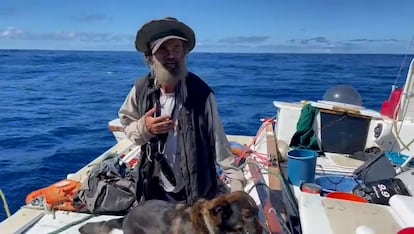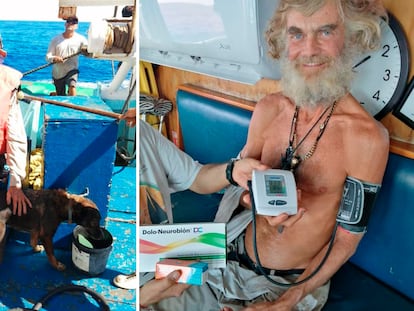Tim Shaddock, the Australian castaway: ‘I was a man in a suit and tie and realized I needed to change my life’
The sailor, rescued by a Mexican tuna boat, talks to EL PAÍS about his life, the time he spent adrift in the Pacific and his dog Bella

Tim Shaddock used to spend his days working for a large tech company. “I was a very different man, wearing a big suit and tie, and it was not right for me. I realized I needed to change my life,” he says. So, one day he took his computer and went into the depths of nature, in the mountains and remote places in Asia. Then he turned to the sea — a sea that would come close to ending his life. In 2020, his path led this Australian to Mexico, where he decided to sail from La Paz, in the state of Baja California Sur, to French Polynesia. Nearly 1,200 miles away from land and without communication, a storm tore off his sail, killed his engine and left him adrift in the widest part of the Pacific. A tuna boat found him on July 12 and rescued him along with his dog, Bella. Now, at the coast of the Mexican state of Colima, he looks back on the 90 days he survived between the sky and the water, eating raw fish and the occasional duck that landed on his catamaran.
The waves of the Pacific break the silence at the beach of Manzanillo, the capital of Colima. Shaddock has been there since last Tuesday, staying in one of the hotels that make up the local skyline, stabilizing his health and trying to straighten out his immigration status. He cannot forget the three months he was adrift with his dog. The sailor has deep blue eyes, an unfastened cap and a thick beard. He just woke up from his nap. “I’m very well. I’m being looked after here. I’m very grateful to all the people that saved my life. I’m much better now here than I was at sea.”

The possibility of doing remote work led Shaddock to move away from his native Sydney to the United States. Then the Covid-19 crisis began to turn the world upside down. The pandemic caused Australia to close its borders for more than a year, leaving thousands of Australians out (“I was one of 20,000,” he says). His stay was complicated by visa restrictions, so he decided to travel to Queretaro, Mexico, where he worked remotely for a while. About three years ago, he met Bella in the mountains of nearby San Miguel de Allende. She was a little cattle dog: “She followed me everywhere. I thought, ‘Whoa, I can’t have a dog.’” But she kept following him, no matter what he did.
After several months stuck at the Mexican border, he decided to change his strategy, so he drove to Puerto Vallarta, Jalisco — with Bella on the passenger seat — where he purchased the Aloha Toa, a small catamaran that he made into his home. “Once I started living on the boat, it was too hard to work on the computer.”
He started planning his trip across the ocean two years ago. “When I first bought the boat, it was coming into summer and hurricane season. And so I had to stay [in Puerto Vallarta] and wait to even sail across the Sea of Cortez to La Paz.” That first year, he began to adapt the boat for his future journey. “I had to have a way of making sure that I only used fuel for getting in and out of port and sailed the rest of the time.”
Phones, GPS and an odyssey
The air of the port of Manzanillo has a distinct aroma of fresh fish. The place was one of the first views seen by the Australian last Tuesday upon his arrival on the coast. As the sun burns, people take refuge in the shade of the trees. René Tapia, 53, sweeps the floor, protected by a long-sleeve polo shirt and a hat. He has heard about the Australian man who was found almost 1,200 miles away: “Thank God it was possible for him to be rescued. How strange; if we have a hard time finding food for three months here [on land], just imagine doing it there...” Before working in cleaning, he says that he was part of the crews of Grupomar (the company that owns the tuna vessel María Delia) until a giant tuna fell on his shoulder and knocked him into the sea, forcing him to give up his job. Tapia says that on those journeys, that used to last “20, 30 or 50 days,” they also found cases like Shaddock’s: sailors whose engines broke down.
This year, Shaddock decided to take the next step to start his journey across the vast ocean. He inspected the boat and began the open sea trial, traveling to La Paz. “That’s the year I finally said, ‘okay, I’ve conquered the Sea of Cortez.’ How could I do the same with the Pacific?” The trial made him see that he could not carry much fuel or water. He finished the alterations in the Aloha Toa: he installed solar panels to ensure the operation of the equipment, set up a water desalination system, prepared some food reserves and tried to make it lighter to ease the use of the sail. He also got several GPS devices, as well as cell phones that might serve as backup with downloaded maps that could be used without a connection. Despite these systems, the María Delia was the only vessel to approach the catamaran.
Shark sushi
The Australian prepared some provisions before starting the trip: some rice, cans of tuna and some other preserves that would not need refrigeration. On the boat, he tried to alternate that food with fishing: when there was no catch, he resorted to the cans. “My dog and I would eat together and drink water together from a cup. She would always be eating with me. I’d eat some, and then I’d give her some. If I had a fish, we’d be cutting the fish up, and she would eat it, bones and all.”
Shaddock hunted and fished in a variety of ways. He would drop the catamaran’s anchor in the water, take a deep breath and climb down the rope with a fishing speargun. He waited patiently for a fish to pass by, and then he struck. The situation varied, depending on the day: a duck would land on the boat and begin to quack. Bella would bark, as if she were saying something to the bird. The Australian would stand up quickly, grab it by the neck and slits its throat. Other times, the reward was greater: he would throw a line into the water and manage to catch a shark. He would drag the animal to the back of the boat and stab it. “And so it was: shark sushi,” he jokes. At first, he cooked the food with a small stove, but it soon broke down. After being diagnosed with cancer in the 1990s, he had started a raw vegan diet, which he has alternated over time. “But I would always go back to meat if I got too skinny, like I am now,” he points out.
One of the storms that crossed the Pacific destroyed the boat’s engine and sail. Shaddock attempted to fix the sail, but he bumped several times into the mast while attempting to climb it. In the end, he preferred to lower it; there was no way to fix it at the moment.
On July 7, Hurricane Calvin began to form about 200 miles from Manzanillo. On its way to the Pacific, it began to lose steam (it reached gusts of 93 miles per hour). On July 12, about 125 miles off the coast of Colima, Shaddock was still adrift and close to the hurricane, which could have been fatal. “That was a complicated time. When the storm comes, your options are very minimal [...] There’s no way you can stay up on the boat trying to do much.”
He was lucky. A helicopter that was flying over the area in search of the dark spots made by schools of fish in the sea saw the small white boat and notified the tuna vessel María Delia. Then a small boat from the ship approached the Aloha Toa.
“I have to make a decision now,” Shaddock remembers thinking. “I have to go with these people. Or if I don’t go, will I survive? And it became clear that I probably would not survive.” The sailor got on the boat, but he did not cry until he was safe and sound on board the María Delia.
Bella, the pup that grew stronger
The crew found the dog to be healthier than the castaway. Bella immediately approached Genaro Rosales, one of the ship’s navigators. Rosales began, together with one of his companions, to take care of a wound that the dog had in an armpit, and both grew fond of each other. The Australian saw how he treated her: “He loved Bella, and I was very happy for her to go with him.” Rosales has now adopted her.

Shaddock remembers Bella as that puppy he found in San Miguel de Allende, who over time became a strong dog (“stronger than me,” he says). He admits that Australia’s restrictions on the importation of dogs and cats — and the fact that they go through a minimum of 10 days of quarantine and have to be subject to several tests — were part of the decision to give Bella away. “If it had been easy to take her to Australia, then I maybe would have thought about keeping her. But Australia is an island continent, and they don’t have anything like rabies or anything like that. She was with me at sea for three months. That’s enough quarantine, right? I wanted her to be happy. I didn’t want to put her through all of those things,” he explains.
From the hotel where he rests, the waves of the Pacific can be seen crashing against the coast. On occasion, one can hear the horns of the ships that float on the horizon.
Will he sail again? “I think I will sail in the future, probably on a much bigger boat,” he jokes. “Maybe a cruise ship, you know, just sit in my lounge, eat my food, air conditioning and a big TV screen.”
Sign up for our weekly newsletter to get more English-language news coverage from EL PAÍS USA Edition









































